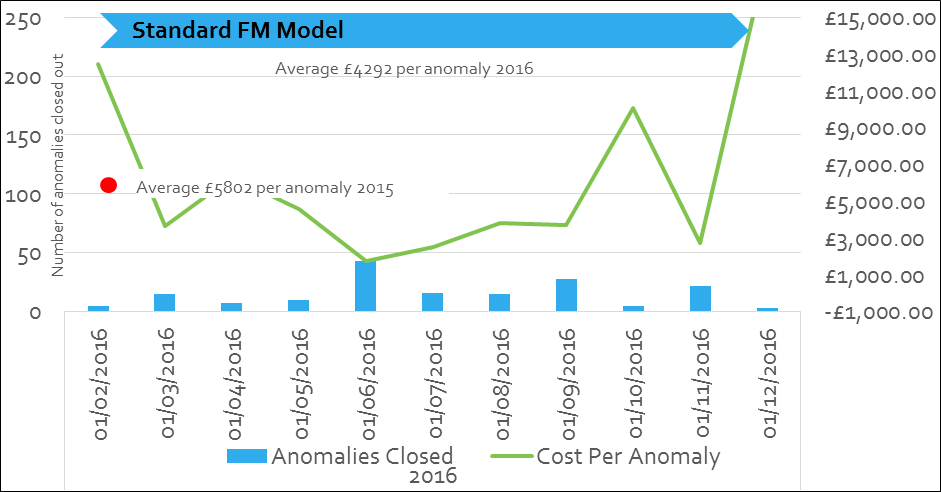ONE AIM – UK North Sea Facilities Fabric Maintenance Case Study
June 2017: an IQ Integrity client kindly provided this version of their UK North Sea Facilities Fabric Maintenance Case Study management presentation. This compares standard workflow and spreadsheet / documentation versus enhanced inspection and fabric maintenance workflow, supported by a ONE asset integrity management software solution. (Download Print Version)
Summary
This UK North Sea Facilities Fabric Maintenance case study is constructed from 2016 data and, compared across three platforms.
Our company Inspection and FM procedures and process improvements have been coded and embedded into ONE, meaning every anomaly is reported, review and assessed against our standards consistently across our facility base.
On these platforms, implementation of a pro-active Fabric Maintenance (FM) and Inspection strategy and workflow, which is supported by our ONE integrity management software, has been the foundation and fundamental in realising significant efficiency increases & cost savings, during Inspection reporting and FM execution.
Benefits
Comparisons are:
- Reduction in average cost per anomaly: £3858.00 (£4778.00 vs £920)
- Increased anomalies close-out: Platform B 53 (2015) vs 724 (2016) **
- Inspection reporting efficiency: +36%
The ONE system offers huge benefits in conjunction with a pro-active FM workflow:
- Efficiency and productivity increase
- Cost reduction
- Providing a full audit trail, data consistency and control.
- Rationalising data repositories
- Clear alignment of Anomaly, Defined Life Repair and FM task tracking.
- Offshore execution and onshore preparation.
- Client ‘owned’ system and data – future proofs and de-risks service provider contract changes.
** (242 anomalies closed out in last 4 months of 2016. (242*3) = 724 Full Year)
Platform Comparisons
Asset Information
Three Platforms selected of similar size and age to enable a harmonised data set and closer interpretation of results.
| Platform | Commissioned | Age | Size | Tonnage | Producing | Metallurgy | Type | Integrity Contract Model | ONE Supported |
|---|---|---|---|---|---|---|---|---|---|
| A | 1992 | 24 | 9,000 | 16,500 | Condi & Gas | Carbon Steel | Steel Jacket | INSP/FM Combined | Yes |
| B | 1992 | 24 | 10,400 | 21,100 | Condi & Gas | Carbon Steel | Steel Jacket | INSP/FM Combined | Yes |
| C | 1992 | 24 | 9,100 | 18,200 | Condi & Gas | Carbon Steel | Steel Jacket | INSP/FM Separate | No |
Key points (Work-flow differences)
The significant differences in our platform workflows and execution strategies are listed in this table. There is clear evidence that moving away from the ‘standard methodology’ has benefits for integrity of all platforms, for transparency of risk and remedial actions and, a streamlined workflow.
| Platform B: Execution Strategy | Platform C: Execution Strategy |
|---|---|
| ONE Fully Integrated | Standard Excel based reporting/documentation |
| FM/INSP - Single Contractor | FM/INSP - Two contract model |
| Minimised Data Handoffs | Multiple interfaces both on and offshore |
| Single entity system | Multiple data repositories and hand-offs |
| Current Inspection Data utilised to execute FM (Live-line Blasting Limitations) | Multiple site revisits and inspection activity to facilitate FM |
| All scope captured via inspection input and discipline engineer review. | Multiple inputs into FM priority (* independent from Risk Based approach) |
| Direct credit taken for executed FM in RBI reassessment | No hard wire connection between FM executed activity and RBI reassessment. |
| Aligned Contractor KPIs to full lifecycle risk reduction | Fragmented approach multiple activity owners |
| Clear demonstration to facilities regarding approach/intent and success factors | |
| Clear articulation of facility threats and risk profile | |
| Clear ownership of offshore scope | |
| Combined Planning process. Aligned conservation/decision making |
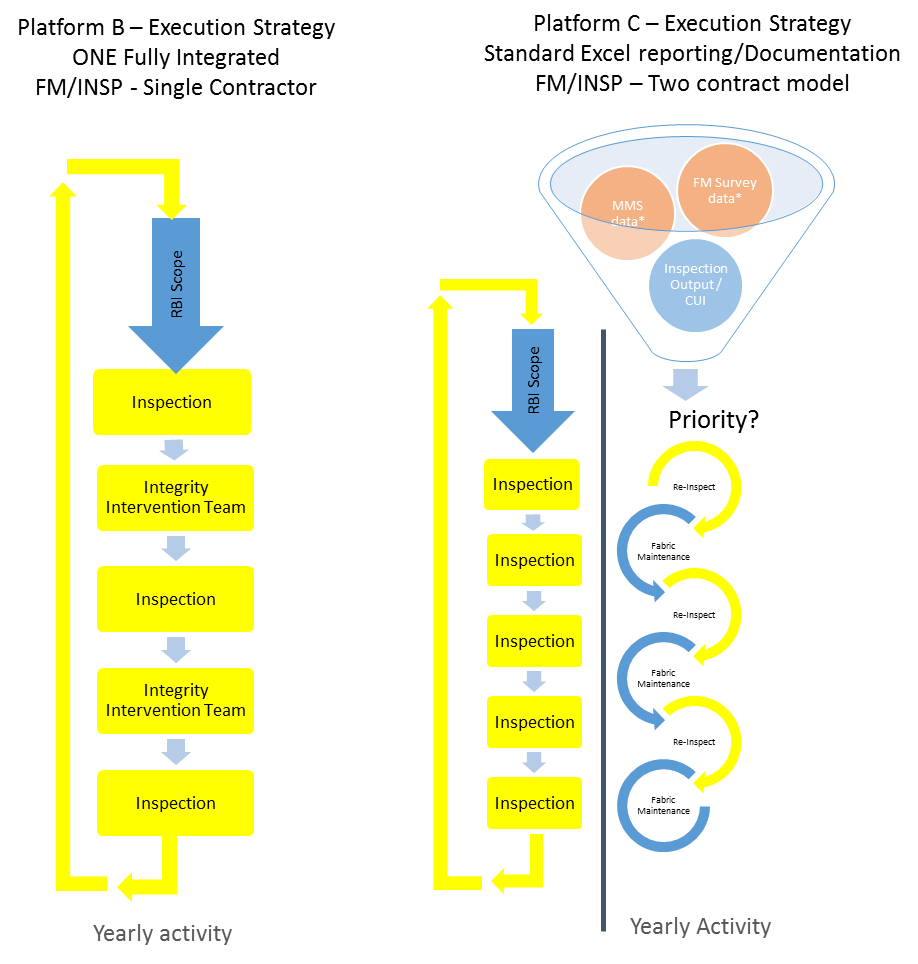
Anomaly Classification
Utilising the system reporting and task functionality re inspections are minimised to facilitate integrity interventions. The differences in approach to anomaly management are illustrated on this chart.
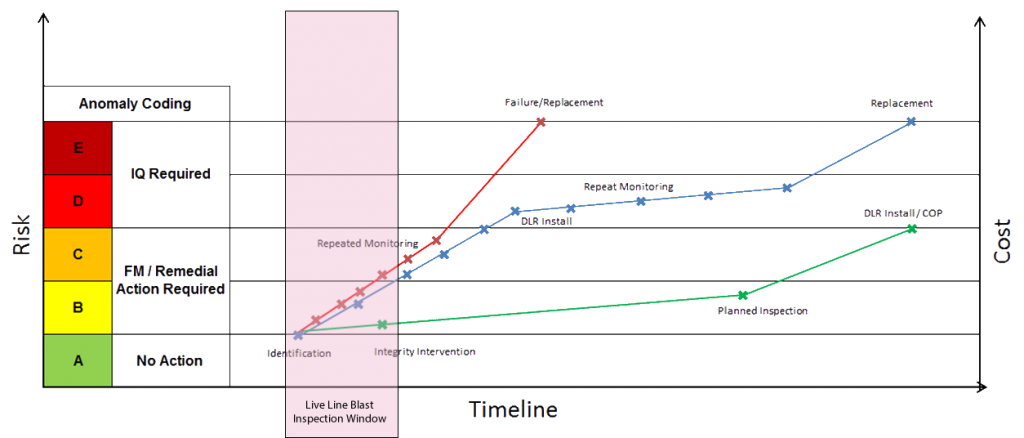
Crosses are Integrity activities (Inspection, FM, Repair and replacement)
An uncontrolled or worst case scenario (red line) to anomaly management, we continue to inspect a FM anomaly and do not mitigate until the component fails or requires replacement. The potential for situation (although rare) is exacerbated by poor data control and workflow management.
Our historical approach (blue line) to anomaly management, we inspect the FM anomaly frequently. With no FM intervention thereby increasing our inspection costs until a point where we need to mitigate with a DLR/Temporary Repair and ultimately increasing the cost . Then we inspect/monitor the mitigation until the component requires to be replaced.
With pro-active optimised workflow (green line), we carry out an appropriate and timely FM mitigation in line with our Live line blast intervention period. This generally enables us to push out the next inspection to the following RBI cycle and reduces or removes the requirement to monitor less than the RBI interval. Following that inspection we, if required, install a DLR/Temporary repair or further FM certified until cessation of production
Here we reduce our known risk and requirement to repeatedly inspect without mitigating the issue, supported by the knowledge management in our ONE system.
2016 Cost per Anomaly Closed Out
Platform A – No ONE System or pro-active FM
- Costs as per standard FM model.
- Repeat inspection to facilitate intervention.
- Standard Coating system and approach.
- Disjointed anomaly close-out QA/QC.
- 2015 Fabric Maintenance Total Spend: £202,629.00
- 2015 Platform A Cost Per Anomaly: £5802.00
- 2016 Anomalies closed out: 172
- 2016 Average cost per anomaly: £4292.92
- Reduction in average cost 2015-2016: 27%
Platform B – ONE Fully Integrated and proactive FM
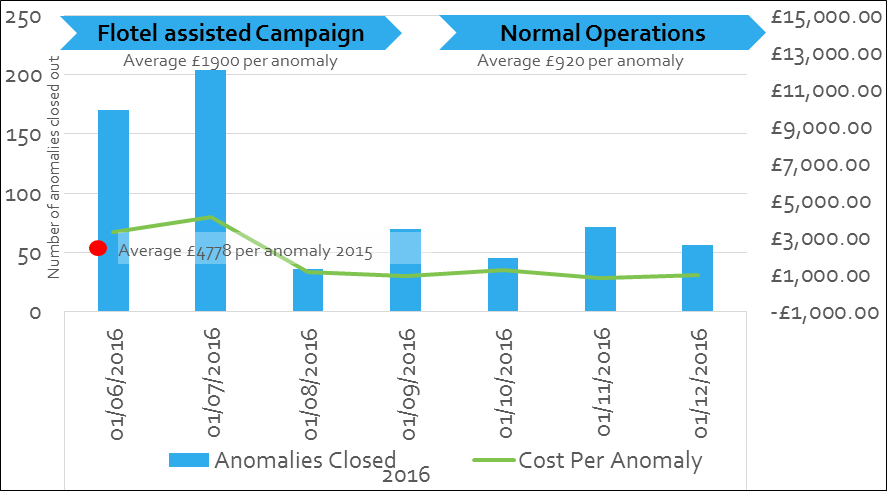
- Integrity Intervention team
- Reduction of inspection burden
- Asset Integrity Provider fully accountable to deliver end to end solution
- Targeted anomaly approach, rationalised coatings.
- Combined close-out.
- Clear/Live concise Integrity driven metrics
- 2015 Fabric Maintenance Total Spend:£255,309.00
- 2015 Platform B Cost Per Anomaly: £4778.00
- 2016 Anomalies closed out: 1133 (Flotel Assisted)
- 2016 Average Flotel Cost per anomaly: £1900
- 2016 Post Flotel cost per anomaly: £920 (System and processes fully established and integrated)
Inspection Reporting
Systemised Inspection and anomaly reporting has realised increased efficiency levels; whilst also increasing reporting standards and auditability.
| Platform B: ONE Fully Integrated | Platform C: Not Supported by ONE | ||
|---|---|---|---|
| Total inspection reports | 732 | Total inspection reports | 868 |
| Inspection man-days available | 696 | Inspection man-days available | 1312 |
| Cost per Inspection Report | £831.00 | Cost per Inspection Report | £1,011.18 |
| Man Hours per inspection activity completed/Reported | 7.8 | Man Hours per inspection activity completed/Reported | 12.3 |
Targeted Reporting – Integrity Led & Performance Driven
System – Integrity threats
All Anomalies risk assessed with tasks and timelines identified for mitigation.
Within the ONE system we have live visibility of anomalies by System and their risk grade, along with the anomaly location area and access requirements for intervention. This allows us to strategically target focus areas that provide maximum risk reduction.
It also gives increased visibility and understanding when shaping business planning assumptions for future integrity presence on our facilities.
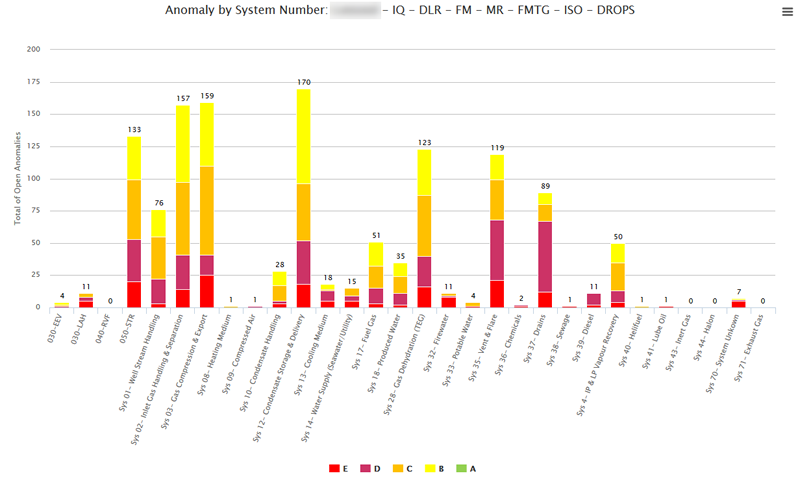
Clear concise reporting
Contractor monthly/annual KPI’s are driven around targeting and execution biggest risks. Our live and historic reporting options visualise anomaly reduction progress and efficiency.
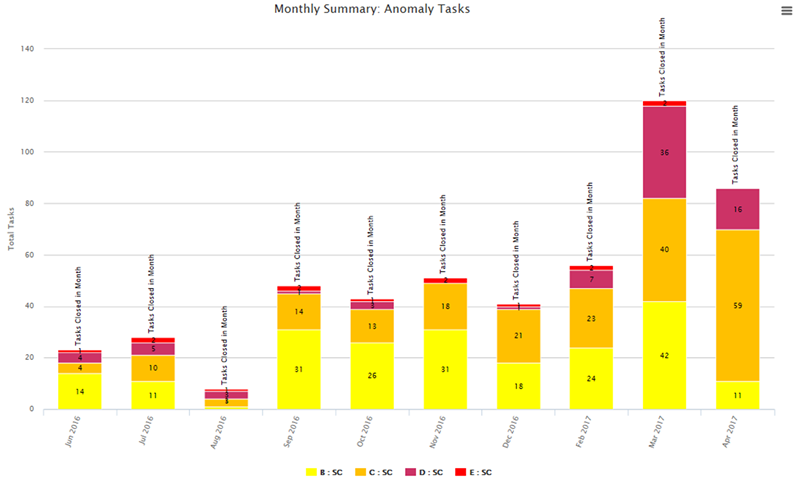
Anomaly Progression
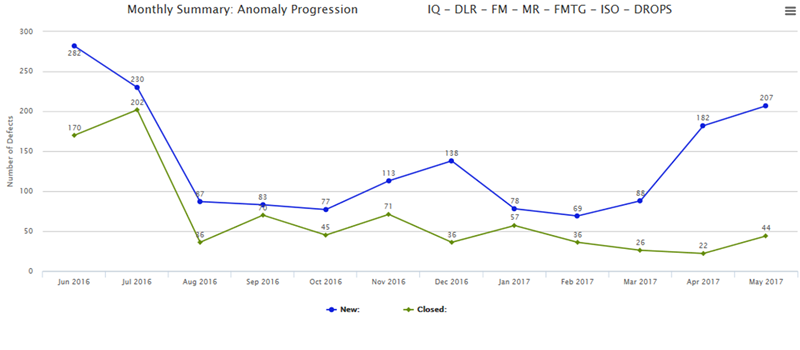
Summary & Next Steps
The application of ONE and development of supporting processes has been fundamental in realising significant efficiency increases & cost savings, during Inspection reporting and Fabric Maintenance execution.
Benefits
- The ONE system offers huge benefits in conjunction with a pro-active FM workflow:
- Efficiency and productivity increase
- Cost reduction
- Providing a full audit trail, data consistency and control.
- Rationalising data repositories
- Clear alignment of Anomaly, Defined Life Repair and FM task tracking. Both offshore execution and onshore preparation.
- Client ‘owned’ system and data – future proofs and de-risks service provider contract changes.
Future
Going forward we are looking to establish the following system enhancements which should ultimately allow us to have a single integrated integrity system;
- Inspection register integration
- Inspection work pack generation
- FM work pack generation
- Mobile application – Paper less reporting
- RBA module
(ONE: UK North Sea Facilities Fabric Maintenance Case Study supplied by client: June 2017)

